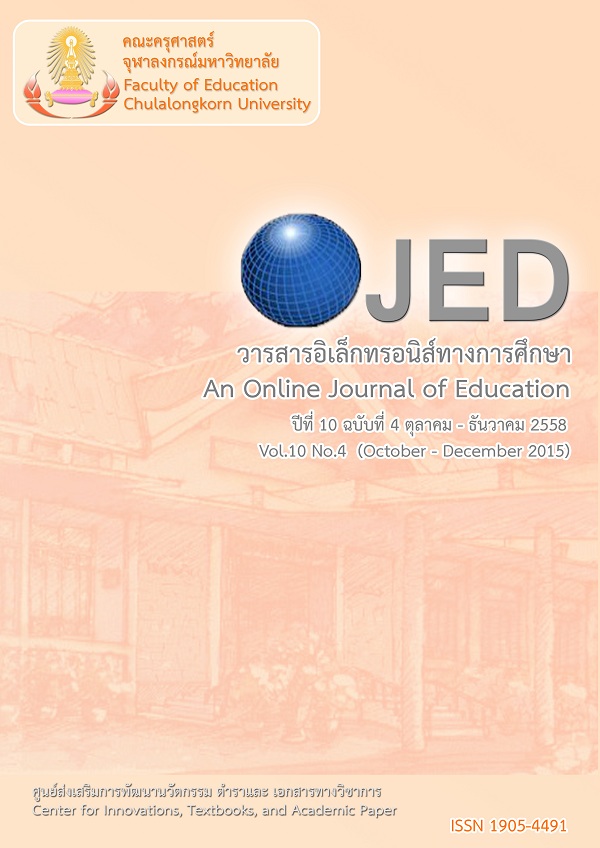การพัฒนาแบบวัดสภาพแวดล้อมเพื่อการเรียนรู้ในห้องเรียนระดับประถมศึกษา
Keywords:
สภาพแวดล้อมในห้องเรียน, CLASSROOM ENVIROMENTAbstract
งานวิจัยครั้งนี้เป็นการวิจัยเชิงบรรยาย มีวัตถุประสงค์เพื่อ 1) เพื่อพัฒนาแบบวัดสภาพแวดล้อมเพื่อการเรียนรู้ในห้องเรียนระดับประถมศึกษา 2) เพื่อตรวจสอบคุณภาพแบบวัดสภาพแวดล้อมเพื่อการเรียนรู้ในห้องเรียนระดับประถมศึกษา ตัวอย่างที่ใช้ในการวิจัยครั้งนี้ได้แก่นักเรียนที่กำลังศึกษาอยู่ในระดับชั้นประถมศึกษาปีที่ 4 – 6 สังกัดสำนักงานเขตพื้นที่การศึกษาประถมศึกษากรุงเทพมหานคร จำนวน 405 คน เครื่องมือที่ใช้ในการวิจัย ได้แก่ แบบสอบถาม ลักษณะเป็นแบบเลือกตอบ 2 ระดับ และแบบมาตราส่วนประมาณค่า 5 ระดับ วิเคราะห์ข้อมูลด้วยสถิติบรรยาย โดยหาค่าความเที่ยงของแบบวัด ผลการวิจัยสามารถสรุปได้ดังนี้ 1. แบบวัดสภาพแวดล้อมเพื่อการเรียนรู้ในห้องเรียนประถมศึกษา แบ่งสภาพแวดล้อมเพื่อการเรียนรู้ในห้องเรียน ออกเป็น 2 ประเภท คือ 1) สภาพแวดล้อมทางกายภาพ และ 2) สภาพแวดล้อมทางสังคม ซึ่งแต่ละด้านมีองค์ประกอบดังนี้ 1) สภาพแวดล้อมทางกายภาพ ประกอบด้วย 11 องค์ประกอบ ได้แก่ 1) การใช้สีของผนัง 2) ขนาดห้องเรียน 3) อุณหภูมิในห้องเรียน 4) แสงสว่างในห้องเรียน 5) การจัดป้ายนิเทศ 6) เสียงและการได้ยิน 7) สิ่งอำนวยความสะดวกสำหรับคนพิการ 8) ความแออัดในห้องเรียน 9) สื่อการสอนในห้องเรียน 10) ความปลอดภัยในห้องเรียน 11) การจัดที่นั่งในห้องเรียน และ 2 )สภาพแวดล้อมทางสังคม ประกอบด้วย 10 องค์ประกอบ ได้แก่ 1) ปฏิสัมพันธ์ระหว่างครูกับนักเรียน 2) การสนับสนุนจากครู 3) การตัดสินใจร่วมกัน 4) การจัดการเรียน
การสอน 5) การรับฟังความคิดเห็น 6) การให้คำปรึกษา 7) ปฏิสัมพันธ์ระหว่างเพื่อนร่วมชั้นเรียน 9) การจัดการในชั้นเรียน 10) ความท้าทายในห้องเรียน 2.ผลการตรวจสอบคุณภาพแบบวัดพบว่ามีความตรงตามเนื้อหา(ค่าดัชนี IOC ระหว่าง 0.60 ถึง 1.00)
มีค่าความเที่ยง (α = 0.608 - 0.881)
The purposes of this research were: 1) Development of A Classroom Learning Environment Scale
For Primary Education 2) to determine the quality. The sample this study includes students studying in grade
4 - 6 in the jurisdiction of primary education, Bangkok. The 405 Students were used to be sample in this study. The questionnaire with Likert scale and close-ended were analyzed descriptive statistics. By calculating reliability of the measurements and confirmatory factor analysis (Confirmatory Factor Analysis) findings can be summarized as follows: 1. the environment scale for primary classrooms which shared into two categories. 1) Physical Environment and 2) The Social Environment. Each categories has the following elements:
1) the physical environment consists of 11 elements 1) the color of the walls 2) class sizes 3) The temperature in the classroom 4) classrooms lighting 5) The boards 6) sound and hearing 7) facilities for - the disabled 8) density of student in classroom 9) the material elements the classroom 10) Safety in Class 11) the seating arrangement in the classroom and 2) The social environment consists of 10 elements including 1) the interaction between teachers and students 2) supporting from teachers 3) co-making a decision and 4) the instruction 5) the sharing idea 6) Counseling 7) interaction between classmates 9) classroom management 10) Challenging in the classroom 2. The finding found that the questionnaire validity (IOC index values between 0.60 to 1.00), the reliability (α = 0.608 -0.881)




